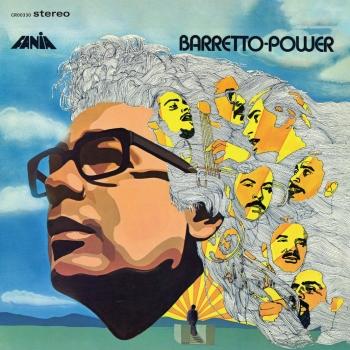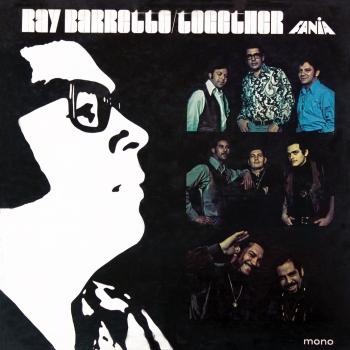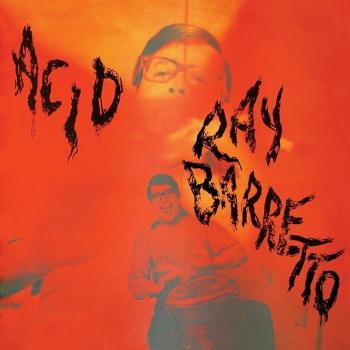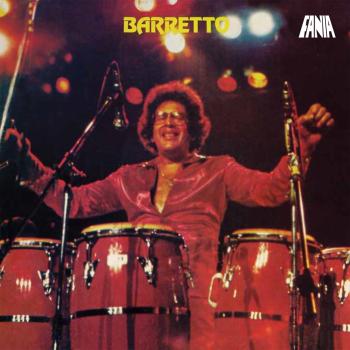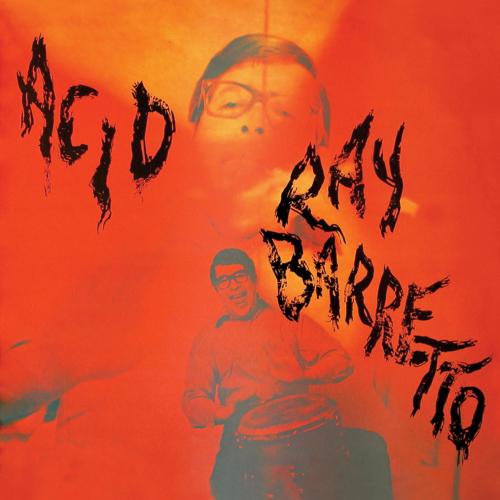
Acid (Remastered 2024) Ray Barretto
Album Info
Album Veröffentlichung:
2024
HRA-Veröffentlichung:
16.02.2024
Das Album enthält Albumcover
Entschuldigen Sie bitte!
Sehr geehrter HIGHRESAUDIO Besucher,
leider kann das Album zurzeit aufgrund von Länder- und Lizenzbeschränkungen nicht gekauft werden oder uns liegt der offizielle Veröffentlichungstermin für Ihr Land noch nicht vor. Wir aktualisieren unsere Veröffentlichungstermine ein- bis zweimal die Woche. Bitte schauen Sie ab und zu mal wieder rein.
Wir empfehlen Ihnen das Album auf Ihre Merkliste zu setzen.
Wir bedanken uns für Ihr Verständnis und Ihre Geduld.
Ihr, HIGHRESAUDIO
- 1 El Nuevo Barretto (Remastered 2024) 05:52
- 2 Mercy, Mercy Baby (Remastered 2024) 02:46
- 3 Acid (Remastered 2024) 05:07
- 4 A Deeper Shade Of Soul (Remastered 2024) 02:49
- 5 Soul Drummers (Remastered 2024) 03:49
- 6 Sola Te Dejaré (Remastered 2024) 03:53
- 7 The Teacher Of Love (Remastered 2024) 02:30
- 8 Espíritu Libre (Remastered 2024) 08:25
Info zu Acid (Remastered 2024)
When a Latin jazz musician releases an album called Acid — in 1968 no less — you would be forgiven for assuming it combines latin music with psychedelic rock. You would be forgiven, but you’d still be wrong. Not a hint, lick or indeed dab of psychedelia is on the entire thing (the eight minute long improvisation of Espiritu Libre comes close, but when the improv is this dry, it’s just called jazz). The only psychedelic thing about the album isn’t even on the album, it’s on the cover. What a waste of psychedelic font.
Ray Barretto’s career has been a long and varied journey. Born in Brooklyn on April 29, 1929, he is the quintessential Nuyorican, a Puerto Rican born and raised in New York City. By the age of two, his family had moved to Manhattan’s Spanish Harlem and by seven, the South Bronx.
Barretto’s bi-cultural experience was reinforced during his stint as a private in the Army during the late 1940’s. “Hangin’ with the black GI’s [in Germany] and hearing the new progressive jazz that was happening then, be-bop, well, I was home.” Being exposed to Dizzy Gillespie’s collaborations with Cuban conguero Chano Pozo further solidified that feeling and inspired him to begin learning the musical intricacies of the conga drum. Barretto led a successful career as a sideman on jazz recordings with leaders like José Curbelo and Tito Puente. He then had success leading a charanga-style ensemble (a Cuban dance band that uses flute and violins) producing a highly successful crossover hit, El Watusi.
But Ray was ready for a change. He formed a conjunto, a small Cuban-style dance band, with two trumpets and a rhythm section. “Jerry Masucci of Fania sought me out and the time was right. The title, Acid, was his idea.” By 1966 a new sound had appeared on the New York dance music scene—Latin Boogaloo. A unique combination of son montuno, cha-cha-cha and R&B, this new sound was put down by many established bandleaders and purists, but Barretto embraced it. “I had been Black for a long time besides being Puerto Rican. It was part of growing up in New York.” And so the album opens with the funky, hard-driving son montuno titled El Nuevo Barretto. Listen closely to the opening break/trumpet phrase. Carlos Santana would recycle it later in his version of Tito Puente’s Oye Como Va. On Mercy, Mercy, Baby, vocalist and fellow Nuyorican Pete Bonet, easily riffs in English, reflecting the influence African-American culture has had on the New York-Puerto Rican experience.
One of the gems on this recording is the title tune, Acid. It’s simple, funky bass tumbao (a repetitive, rhythmic pattern) is played by the late great, legendary Cuban-American bassist, Bobby Rodriguez, who Barretto affectionately dubbed, “Big Daddy.” The result, recorded in one take, is a tour de force that combines a jazz aesthetic with the drive of Afro-Cuban rhythm. René Lopez’s solo on muted trumpet is equal parts Miles Davis and Dizzy Gillespie, with some funky Cuban shadings and his own Nuyorican attitude. Cuban, timbalero Orestes Vilato, a carry over from Barretto’s charanga, had been with Cuban flute virtuoso José Fajardo’s charanga where he was never featured as a soloist. That completely changed on Acid and Soul Drummers, thus inspiring a new generation of young percussionists. Fellow Cuban trumpeter Roberto Rodriguez plays a soaring lead solo. “Roberto holds a special place in my heart. He held a day job as a manager of an auto mechanic shop and never missed a gig or rehearsal with me and he always played his butt off.
He was a man’s man”. Barretto follows and starts with a quiet open roll that comes out of nowhere and builds to a climax of explosive slaps. The power and energy that he generates exudes exclamations of affirmation from his fellow band-mates. A final piano montuno by Louis Cruz with some final explosive trumpet work by Rodriguez while Lopez plays a tasty moña (a short improvised mambo line) underneath him closes the tune. A Deeper Shade of Soul, Teacher of Love and Soul Drummers, Teacher of Love and Soul Drummers continue in the boogaloo groove. Sola te Dejaréis a straight up, swinging mambo/guaracha about an egotistical woman who winds up alone. It’s a showcase for vocalist Adalberto Santiago’s talents as a sonero (vocal improviser). The closer on the album is the other gem, Espíritu Libre. It opens with a percussive dialogue between Orestes playing mallets on the timbales and Barretto on congas. A haunting melody is stated by Lopez, then mirrored by Rodriguez on muted trumpet. Big Daddy enters with a bass line in 6/8 meter accompanied by Santiago unwavering on a small bell. While Bonet strikes a jawbone, Barretto and Vilato converse over the West African-rooted rhythm known as bembé . Featured soloist Lopez uses some nice special effects and pianist Louis Cruz adds some unexpectedly eerie blues phrases as the intensity builds and finally comes to an abrupt halt. A recapitulation of the haunting melody of these two trumpets closes the piece and ends this journey to Africa. “Jazz is always at the core of what I do musically,” Barretto always said.
As the most recorded hand percussionist in jazz history, and a leading force in salsa, this indeed is the case. In the New York/Puerto Rican experience, this duality is the norm, not the exception. From the early Latinos in New Orleans who participated in jazz’s birth, to Nuyoricans like maestro Barretto, this rich musical journey continues. Welcome to part of that journey— Barretto’s debut album for Fania, Acid.
Ray Barretto, musical director, congas
Roberto Rodriguez, trumpet
René Lopez, trumpet
Orestes Vilato, timbales
Louis Crúz, piano
Bobby “Big Daddy” Rodriguez, bass
Adalberto Santiago, Spanish lead vocals, clave on Acid, maracas on Sola Te Dejaré, cha–cha bell on Espíritu Libre, tambourine and cencerro (bongó bell) on El Nuevo Barretto
Pete Bonet, English vocals, guiro, quijada de burro (jaw of a donkey) on Espíritu Libre
Digitally remastered
The most widely recorded conguero in jazz, Ray Barretto grew up listening to the music of Puerto Rico and the swing bands of Duke Ellington, Count Basie, and Benny Goodman. Barretto credited Dizzy Gillespie's recording of "Manteca," featuring conguero Chano Pozo, with his decision to become a professional musician.
He first sat in on jam sessions at the Orlando, a G.I. jazz club in Munich. In 1949, after military service, he returned to Harlem and taught himself to play the drums, getting his first regular job with Eddie Bonnemere's Latin Jazz Combo. Barretto then played for four years with Cuban bandleader/pianist José Curbelo. In 1957, he replaced Mongo Santamaria in Tito Puente's band, with which he recorded his first album, Dance Mania. After four years with Puente, he was one of the most sought-after percussionists in New York,attending jam sessions with artists including Max Roach and Art Blakey and recording with Sonny Stitt, Lou Donaldson, Red Garland, Gene Ammons, Eddie "Lockjaw" Davis, Cannonball Adderley, Freddie Hubbard, Cal Tjader, and Dizzy Gillespie. Barretto was so much in demand that in 1960 he was a house musician for the Prestige, Blue Note, and Riverside record labels.
Barretto's first job as a bandleader came in 1961, when Riverside producer Orrin Keepnews asked him to form a charanga for a recording, Pachanga With Barretto. His next album, Charanga Moderna, featured "El Watusi," which became the first Latin number to penetrate Billboard's Top-20 chart. In 1963, "El Watusi" went gold. In 1975 and 1976, Barretto earned back-to-back Grammy nominations for his albums Barretto (with the prize-winning hit "Guarere") and Barretto Live…Tomorrow. His 1979 album for Fania, Rican/Struction, considered a classic of salsa, was named Best Album (1980) by Latin N.Y. magazine, and Barretto was named Conga Player of the Year. He won a Grammy Award in 1990 for the song "Ritmo en el Corazon" with Celia Cruz.
Barretto was inducted into the International Latin Music Hall of Fame in 1999. He was voted Jazz Percussionist of 2004 by the Jazz Journalists Association and won the DownBeat critics' poll for percussion in 2005. His recording Time Was, Time Is was nominated for a 2005 Grammy Award.
Dieses Album enthält kein Booklet











